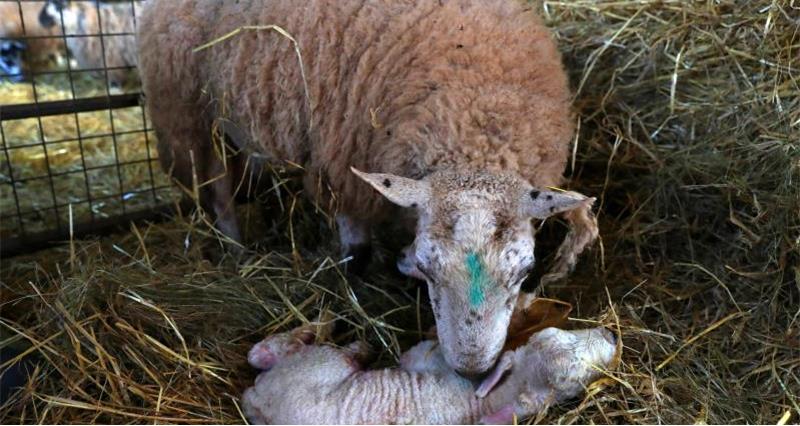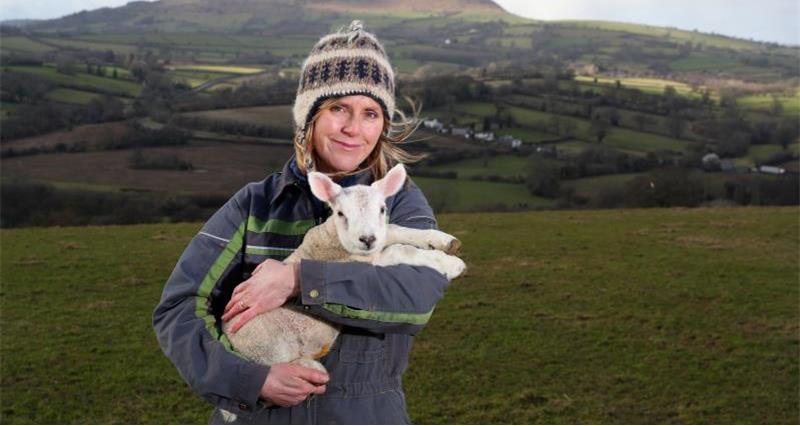For Kate Beavan and husband, Jim, the lambing time of year is one of their busiest. The couple work night and day lambing and it’s all hands to the deck, including son Sam and daughter Celyn lending a hand when needed. The Beavan family run two farms in partnership in Monmouthshire, lambing and impressive 1,500 ewes in total.
“This is fast and furious and we work shifts so there’s always someone checking the ewes,” says Kate. “I cover the early mornings and Jim covers the night shift, with Sam helping out when he’s here – he’s a keen farmer but works away.
“Our sheep consist mainly of mules with Texel and Charollais tups. This year we also put a Suffolk tup on to our North Country Mules and the ewe lambs will be kept to join the flock as replacement breeding ewes. Our Epynt Hardy Speckled sheep lamb outside in March.”
To understand what it’s like for a farm at lambing time, we asked Kate to keep a seven-day diary of life in the lambing shed, and, as you can probably imagine, there wasn’t a dull moment!
Day 1 – Sunday
It’s 5am and I’m standing outside the lambing shed before putting the lights on, and I can hear a ewe ‘talking’ (this sound indicates it’s in the early stage of labour). I go in and turn on the lights to find a ewe lambing and a fresh set of twins in the bonding pens, so Jim must have sorted them in the night.
When the lambs are born we move mum and lamb(s) from the main shed into individual pens to bond. This is particularly essential for first-time mums and also prevents other ewes from pinching the lambs (quite common if they are close to lambing).
I find a ewe has a water bag showing, but all the other ewes are quiet, so time for a quick walk around. I bottle feed Gutsy; his mum loves him but she hasn’t got enough milk.
I also checked the lambing ewe, she’s had her first lamb, so I’m keeping an eye on her while filling hay racks and re-filling buckets with fresh water. Another ewe is showing signs.
Next I have to help the second lamb out – one leg was back (malpresentation), so I find the second leg and deliver the lamb safely. Sprayed the umbilicals with iodine to prevent infection, checked the ewe has plenty of colostrum and put it into bonding pen.
7.30am – I make a cup of tea and take a coffee for Jim – he’s knackered. A single is lambing and has a large lamb, which needs a bit of help. Previous lambs up and suckling – great!
Total born = 17 lambs

Day 2 – Monday
Early shift – one single and a set of twins, all okay, dress umbilicals, check colostrum and pen them up.
Then it’s off to the college to teach Animal Management students. Home in the afternoon and Jim has had six ewes lambed throughout the day. All healthy apart from one.
One ewe had a large lamb born dead. It’s always horrible when this happens as she is a great mum (she has lambed before) and has oodles of milk. Jim removed the skin off the dead lamb and popped it onto Gutsy (a bit like a sweater).
This may sound gruesome, but is a great way of adopting lambs onto new mums. Gutsy suckles straightaway and the ewe loves him as he smells like her own. Gutsy’s mum cannot rear him, so she’s put out into the field to graze.
Jim has been putting ewes and singles put out into fields today. The quicker you can get lambs out the better; you can’t beat fresh air and green grass.
Total born = 20
Day 3 – Tuesday
I take the early shift and there are two sets of twins and two more talking. A single ewe lambs on her own.
I teach trainee veterinary nurses at Coleg Gwent on a Tuesday, but today they’re coming here for some lambing experience and to learn how to stomach tube.
We discuss the role of placentas, they’re usually expelled after an hour or so; I have some lovely fresh ones to show them. The students also have the opportunity to stomach-tube a weak lamb. If you bottle feed a weak lamb you run the risk of colostrum/milk going down the trachea into the lungs which can drown them. Stomach tubing is a life-saving skill and a great way to get the essential colostrum into the stomach.
Before ewes and lambs are put into the fields, they’re numbered so we know which lamb belongs to which ewe if they get lost. The trainee VN’s have been warned that Jim is very fussy about neat numbering and after the first lamb has a perfect 5 sprayed onto it, the poor girl responsible for the second lamb probably overthinks and manages to spray a perfect 5… backwards!
We show them Gutsy and his new mum and remove the old skin. We’ll keep an eye on them through the afternoon, but it’s clear she loves him (thank goodness as the skin is getting a bit smelly).
